Charts of the Week
Charts of the week from 12 to 16 December 2022: natural gas consumption, electricity consumption by consumption group, value of fiscally verified invoices and other charts
Natural gas consumption and industrial and household electricity consumption were lower in November than in the same period in recent years. In addition to the measures to promote rational consumption, electricity and gas consumption were also lower because the industry reacted to the high prices by reducing production output. According to data on fiscal verification of invoices, turnover at the beginning of December was 15% higher year-on-year in nominal terms, supported by high price growth and also last year’s low base related to COVID-19 containment measures. After several years of surplus, Slovenia’s current account in the first ten months was close to being balanced. According to data on the value of construction work put in place, construction activity in October was significantly higher than last year. Compared to previous years, the construction of buildings stands out, and activity in civil engineering was also high. With employment high, the year-on-year growth in the number of persons in employment weakened somewhat in October. It was high in construction, which is characterised by a high proportion of foreign workers and a major labour shortage.
Natural gas consumption, November 2022
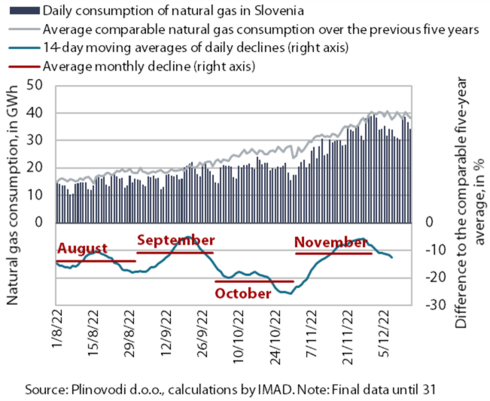
Natural gas consumption in November was 11% lower than the comparable average consumption over the last five years, after being more than 21% lower in October given the unusually warm weather. Consumption was lower due to EU measures to promote rational gas use, while part of industry reacted to the high gas prices by reducing production output and thus gas consumption. After the warmer-than-average weather in the second half of October had additionally contributed to lower consumption, temperatures in November were more comparable to the long-term average and thus the gap to the comparable gas consumption of previous years narrowed. Before the winter season, EU Member States were able to assure that their gas storage capacities were almost full, but storage capacities have gone down as consumption has increased. According to preliminary data, gas consumption in Slovenia from 1 August to 15 December 2022 was 14% lower than the comparable average consumption over the last five years, which is slightly below the EU recommendations for the period between August 2022 and March 2023.
Electricity consumption by consumption group, November 2022
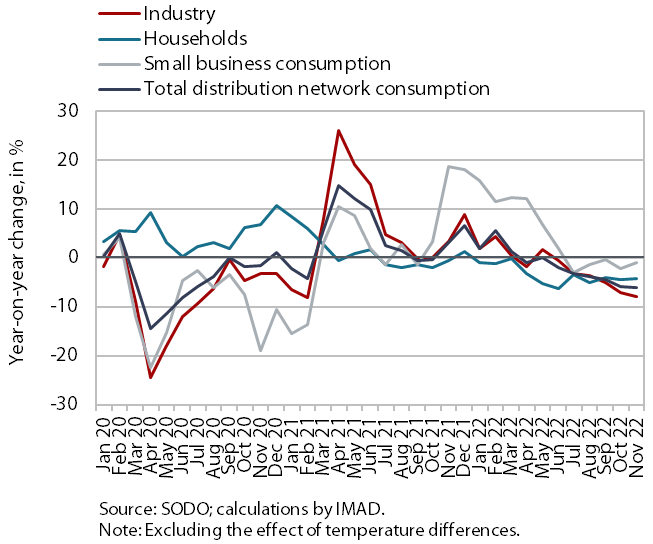
In November, electricity consumption in the distribution network was lower year-on-year in all consumption groups, as it has been for several months now. The strongest decrease was recorded in industrial consumption (by 8.0%). According to our estimate, this was mainly due to the lower consumption by some energy-intensive companies, which reduced their production volume under the impact of high electricity prices and may have adapted their production processes and introduced modern technologies to increase their energy efficiency. Household consumption was also lower year-on-year in November (by 4.2%), most likely due to more rational consumption of energy and fewer people working from home. The decline in small business consumption was much less pronounced, as it was 0.9% lower in November than a year ago.
Value of fiscally verified invoices, in nominal terms, 27 November–10 December 2022
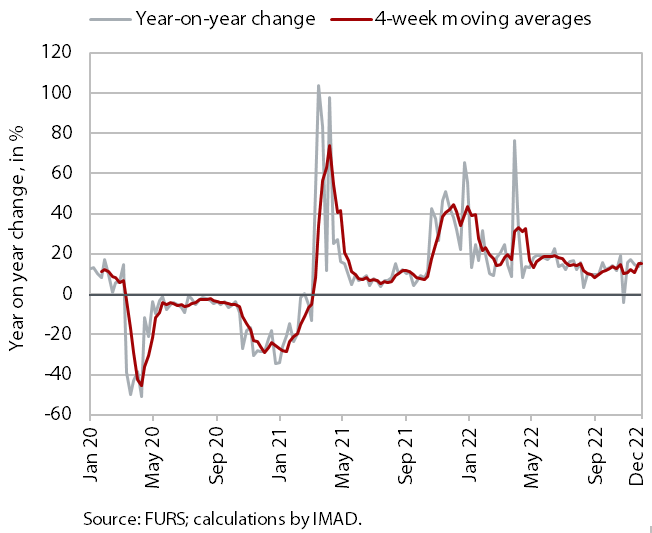
Amid high price growth, the nominal value of fiscally verified invoices between 27 November and 10 December 2022 was 15% higher year-on-year and compared to the same period of 2019. The largest contribution to year-on-year growth, which was similar to that in the last two weeks, came from the 14% nominal growth of turnover in trade, which accounted for almost 80% of the total value of fiscally verified invoices issued. Growth was also significantly influenced by the high nominal turnover growth in accommodation and food service activities (34% overall, 39% in food and beverage service activities), which was mainly due to last year’s lower base.
Current account of the balance of payments, October 2022
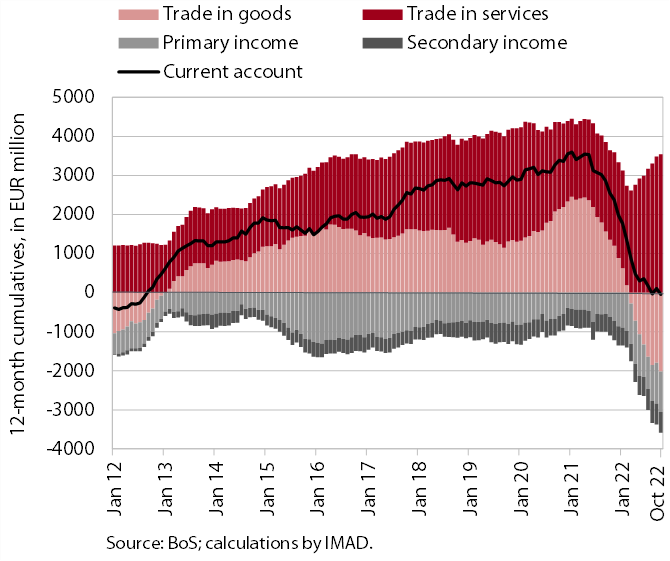
After several years of surplus, the current account is close to being balanced this year. The surplus of the current account of the balance of payments amounted to EUR 56.8 million in the first ten months, noticeably lower than in the same period last year, when it was EUR 2.1 billion. This was mainly due to trade in goods, as the real growth in imports of goods was higher than that in exports, given the deteriorating terms of trade. The sharp increase in the prices of energy and other primary commodities as well as in the industrial producer prices has significantly worsened the terms of trade (by 2.9%) and increased the operating costs of non-financial corporations (companies). The primary income deficit was higher due to lower subsidies from the EU budget and more customs duties paid to the EU budget related to the import of electric vehicles for the entire EU market (via the port of Koper). The higher secondary income deficit was arising from higher private sector transfers abroad. The services surplus increased, especially in trade in travel and in trade in transport services related to the growth of international trade in goods.
Activity in construction, October 2022
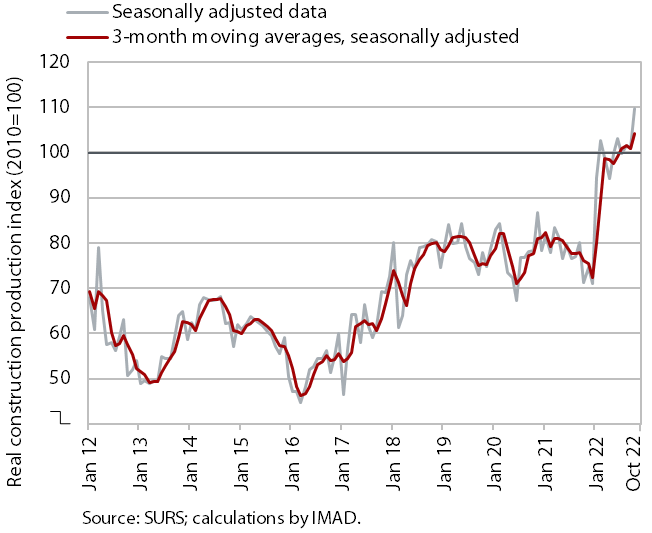
According to figures on the value of construction work put in place, construction activity in October was considerably higher than last year. After a sharp upturn at the beginning of this year, the value of construction work remained roughly unchanged thereafter, before rising again in October, when it was 54.6% higher than in the same month of 2021. Compared to previous years, construction of buildings stands out in terms of activity. Activity was also high in civil engineering, while it was lower in specialised construction work (installation works, building completion). In the first ten months, construction activity was 29% higher year-on-year, while some other data point to much lower growth, with the difference being greatest in the last month. According to VAT data, the activity of construction companies in the first ten months was 6% higher than last year. Data on the value of industrial production in two activities traditionally strongly linked to construction also do not point to such high growth. Production in other mining and quarrying was only 3.9% higher in October than in the same month last year, while in the manufacture of other non-metallic mineral products it was 7.6% lower.
Number of persons in employment, October 2022
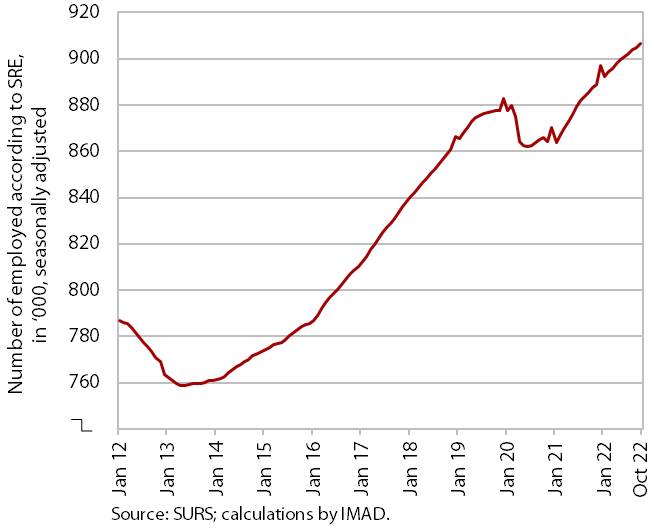
As the number of people in employment reached a record high, year-on-year growth was 2.1% in November, slightly lower than in previous months. It remained high in construction, which faces major labour shortages. The employment of foreign workers has recently been increasingly contributing to overall growth in the number of people in employment – in October, foreign workers contributed 77% to year-on-year employment growth. Consequently, the share of foreign nationals among all persons in employment is also increasing, up 1.3 p.p. to 13.8% in the last year. Activities with the largest share of foreign workers are construction (47%), transportation and storage (32%) and administrative and support service activities (26%). In the first ten months, the number of people in employment rose by an average of 2.6% year-on-year.
